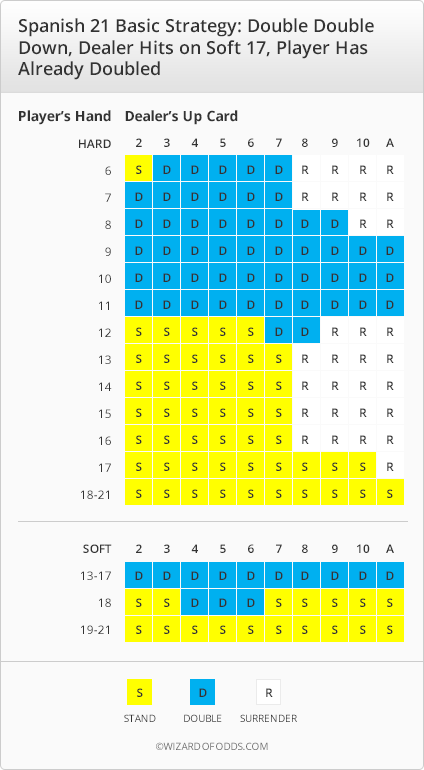Basic Strategy For Spanish 21
- Basic Strategy Card For Spanish 21
- Strategy For Spanish 21
- Basic Strategy For Spanish 21
- Basic Strategy For Spanish 21
HitOrSplit.com offers free blackjack and Spanish 21 games and trainers to help you master basic strategy. Print strategy cards and learn to play blackjack. Spanish 21 Strategy is More Than Basic Blackjack. Spanish 21 is a version of blackjack that is very similar in structure to the original game. As in traditional blackjack, it is a very useful tool to have the “basic strategy” chart for Spanish 21. Guide to Blackjack including; What is the correct basic strategy for single deck Blackjack? And Why are single deck games better than multi-deck games?
Imagine playing the game of Blackjack with a 48-card deck that contains no natural 10’s. That is exactly the concept behind Spanish 21, a fast-paced casino table game that uses six or eight “Spanish” decks without 10-spots. It is still possible to get a two card 21 with an Ace and a face card, but the elimination of 10’s adds a new dimension to doubling down and other aspects of the game.
On the face of it, removing the 10’s should improve the house edge significantly, and it does—by about 25 percent. But the way Spanish 21 rules are set up, the odds in favor of the dealer winning a hand can actually be less than they are in classic Blackjack.
For one thing, doubling is allowed at any time on any card total. Also, redoubling is allowed after a double. The player’s blackjack beats the dealer’s blackjack, which would normally be a push or even money at best. And the player’s 21 beats the dealer’s 21, which would always be a push, otherwise.
Other differences separating Spanish 21 from classic Blackjack include:
– Aces can be re-split.
– Hitting and doubling down are allowed after splitting Aces.
– Late surrender is allowed (except facing a dealer’s natural blackjack).
– “Double Rescue” allows surrender after doubling down.

– Five-card 21 pays 3-to-2.

– Six-card 21 pays 2-to-1.
– Seven-card (or more) pays 3-to-1.
– Mixed suit 6-7-8 or 7-7-7 pays 3-to-2.

Basic Strategy Card For Spanish 21
– Same suit 6-7-8 or 7-7-7 pays 2-to-1.
Strategy For Spanish 21
To keep the game interesting and players on their toes, a number of variable rules can be applied depending on the casino. These include allowing bonuses to be paid on split or doubled down hands; a Super Bonus paid on suited 7-7-7 when the dealer is showing a 7; and special rewards for bonus hands in spades. Some casinos have the dealer stand on soft 17, while others require a hit. And some house rules limit the number of redoubles to three or fewer.
Obviously, the strategy for play is affected by the missing 10’s and the special rules. For example, players can be more aggressive about hitting, with somewhat less concern about busting and more incentive to reach a multi-card 21 total. One basic tenet is to always stand on 18 or more and hit any total of 8 or less. Strategies for hitting, splitting, standing, and surrendering on totals of 9~17 can be quite complex.
Basic Strategy For Spanish 21

Ironically, although there are more opportunities to double down in Spanish 21, the times it is wise to do so are actually less frequent. That’s because of the 25 percent reduction in the number of cards valued at 10. As a general rule, avoid doubling on soft hands except soft 16 against a dealer’s 6 and soft 17 or 18 facing a 4, 5 or 6. As for hard totals, doubling is a good idea on 9 facing a 6; 10 facing a 2~7; and 11 facing 2~8.
Under the basic rules for Spanish 21, the house edge is just 0.40~0.42 percent, which is considerable better than Roulette or Craps. If redoubling is not allowed and the dealer hits on soft 17, the house advantage increases to 0.76 percent, so look for versions that permit redoubles and force the dealer to stand on all 17’s.
Basic Strategy For Spanish 21
Also, look for other rule variations that can affect the odds. A six-deck game is usually preferable to one using eight decks. The existence of an envy bonus paid to active players when a Super Bonus is hit will lower the house edge slightly. And if a face card with an Ace is allowed to count as a blackjack after splitting, that obviously favors the player.